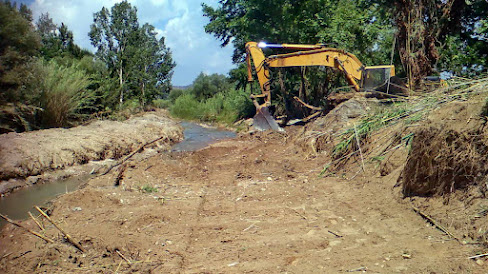Colonies of microbes flourish on tiny bits in the ocean
By Lonny Lippsett Originally published online December 17, 2013
Scientists have discovered a diverse multitude of microbes colonizing and thriving on flecks of plastic that have polluted the oceans—a vast new human-made flotilla of microbial communities that they have dubbed the “plastisphere.”

A scanning electron microscope reveals diatoms (blue shaded) and bacteria with filamentous appendages aboard rafts of plastic flotsam.
(Erik Zettler, Sea Education Association/Tracy Mincer, Woods Hole Oceanographic Institution/Linda Amaral-Zettler, Marine Biological Laboratory)
In a study published July 2013 in Environmental Science & Technology, a team of scientists says the plastisphere represents a novel ecological habitat in the ocean and raises a host of questions: How will it change environmental conditions for marine microbes? Will it favor some over their competitors? How will it change the overall ocean ecosystem and affect larger organisms? How will it change where microbes, including pathogens, will be transported in the ocean?
The team—Erik Zettler from Sea Education Association (SEA), Tracy Mincer from Woods Hole Oceanographic Institution (WHOI), and Linda Amaral-Zettler from the Marine Biological Laboratory (MBL), all in Woods Hole, Mass.—analyzed millimeter-size fragments of plastic debris that were skimmed with fine-scale nets from the sea surface at several locations in the North Atlantic Ocean. They were collected and processed by students participating in SEA research cruises.
“We’re not just interested in who’s there. We’re interested in their function, how they’re functioning in this ecosystem, how they’re altering this ecosystem, and what’s the ultimate fate of these particles in the ocean,” Amaral-Zettler said. “Are they sinking to the bottom of the ocean? Are they being ingested by other organisms? If they’re being ingested, what impact does that have?”
Using scanning electron microscopy and gene sequencing techniques, they found at least 1,000 different types of bacterial cells on the plastic samples, including many species yet to be identified. The colonies included plants, algae, and bacteria that manufacture their own food (autotrophs), animals and bacteria that feed on them (heterotrophs), predators that feed on these, and other organisms that establish symbiotic relationships. These complex communities exist on plastic bits hardly bigger than the head of a pin, and they have arisen with the explosion of plastics in the oceans in the past 60 years.
“The organisms inhabiting the plastisphere were different from those in surrounding seawater, indicating that plastic debris acts as artificial ‘microbial reefs,’ ” Mincer said. “They supply a place that selects for and supports distinct microbes to settle and succeed.”
These communities are likely different from those that settle on naturally occurring floating material such as feathers, wood, and algae, because plastics offer different conditions, including the capacity to last much longer without degrading.
On the other hand, the scientists also found evidence that microbes may play a role in degrading plastics. They saw microscopic cracks and pits in the plastic surfaces that they suspect were made by microbes embedded in them, as well as microbes possibly capable of degrading hydrocarbons.
“When we first saw the ‘pit formers’ we were very excited, especially when they showed up on multiple pieces of plastic of different types of resins,” said Amaral-Zettler. “Now we have to figure out what they are by genetically sequencing them and doing experiments.”
The plastic debris also represents a new mode of transportation, acting as rafts that can convey harmful microbes, including disease-causing pathogens and harmful algal species. One plastic sample they analyzed was dominated by members of the genus Vibrio, which includes bacteria that cause cholera and gastrointestinal maladies.
This project was funded by the National Science Foundation and a pilot award from the Woods Hole Center for Oceans and Human Health.
Read through WHOI Oceanus Magazine
PDF Behold the ‘Plastisphere’ _ Oceanus Magazine

Suctorian ciliate covered with symbiotic bacteria, along with diatoms, and filaments on weathered and cracked microplastic debris. (Image courtesy of Erik Zettler, Sea Education Association)
What happens to plastic in the sea
Related article
Microbes Hitch Rides on Plastics in the Sea
Scientists reveal hidden microscopic world on floating plastic debris
Originally published online November 5, 2010
Reference paper
Life in the “Plastisphere”: Microbial Communities on Plastic Marine Debris
Erik R. Zettler, Tracy J. Mincer, Linda A. Amaral-Zettler
Environ. Sci. Technol., 2013, 47 (13), pp 7137–7146
Abstract

Plastics are the most abundant form of marine debris, with global production rising and documented impacts in some marine environments, but the influence of plastic on open ocean ecosystems is poorly understood, particularly for microbial communities. Plastic marine debris (PMD) collected at multiple locations in the North Atlantic was analyzed with scanning electron microscopy (SEM) and next-generation sequencing to characterize the attached microbial communities. We unveiled a diverse microbial community of heterotrophs, autotrophs, predators, and symbionts, a community we refer to as the “Plastisphere”. Pits visualized in the PMD surface conformed to bacterial shapes suggesting active hydrolysis of the hydrocarbon polymer. Small-subunit rRNA gene surveys identified several hydrocarbon-degrading bacteria, supporting the possibility that microbes play a role in degrading PMD. Some Plastisphere members may be opportunistic pathogens (the authors, unpublished data) such as specific members of the genus Vibrio that dominated one of our plastic samples. Plastisphere communities are distinct from surrounding surface water, implying that plastic serves as a novel ecological habitat in the open ocean. Plastic has a longer half-life than most natural floating marine substrates, and a hydrophobic surface that promotes microbial colonization and biofilm formation, differing from autochthonous substrates in the upper layers of the ocean.
Read through Environmental Science & Technology ( requires subscription )
♦
Zettler ER, Mincer TJ, & Amaral-Zettler LA (2013).
Life in the "plastisphere": microbial communities on plastic marine debris.
Environmental science & technology, 47 (13), 7137-46
PMID: 23745679
♦
____________Tracing Knowledge____________







.webp)


.jpg)







